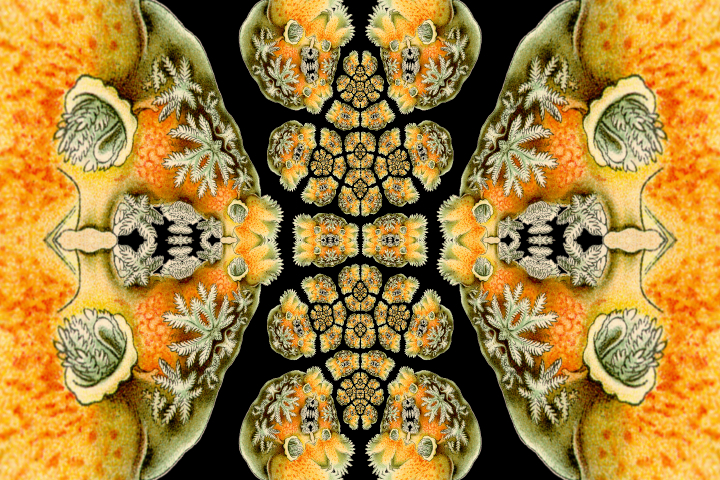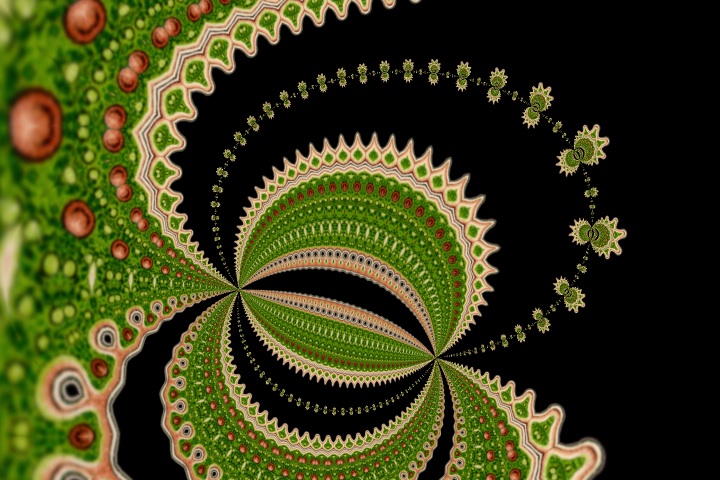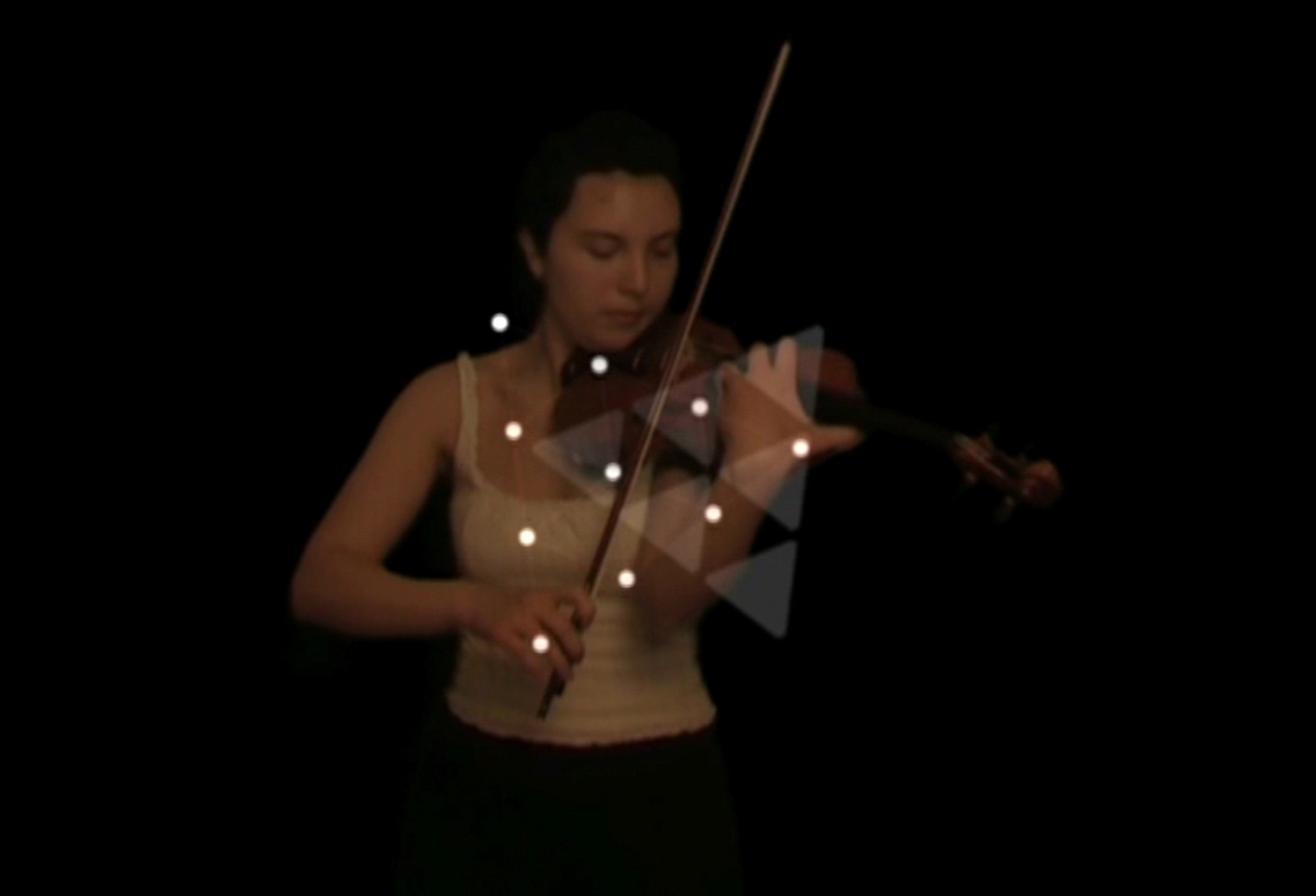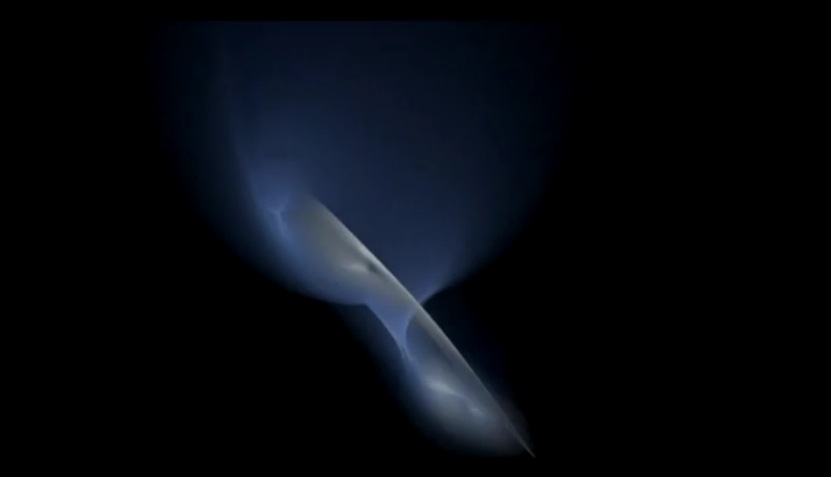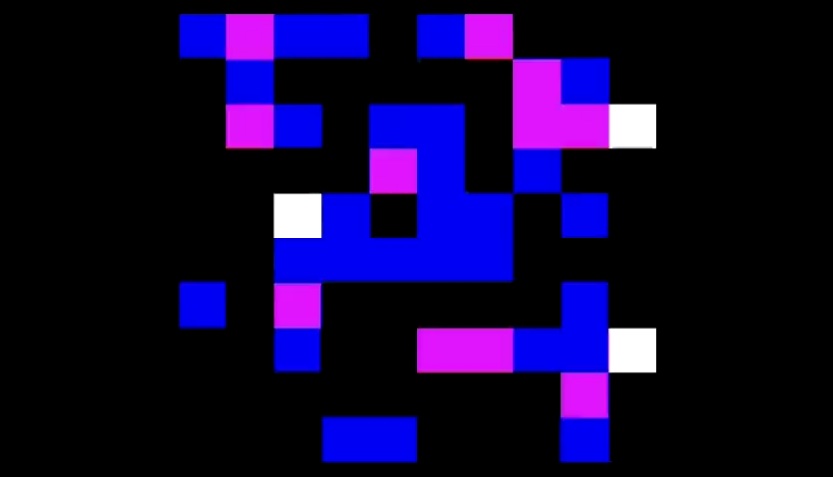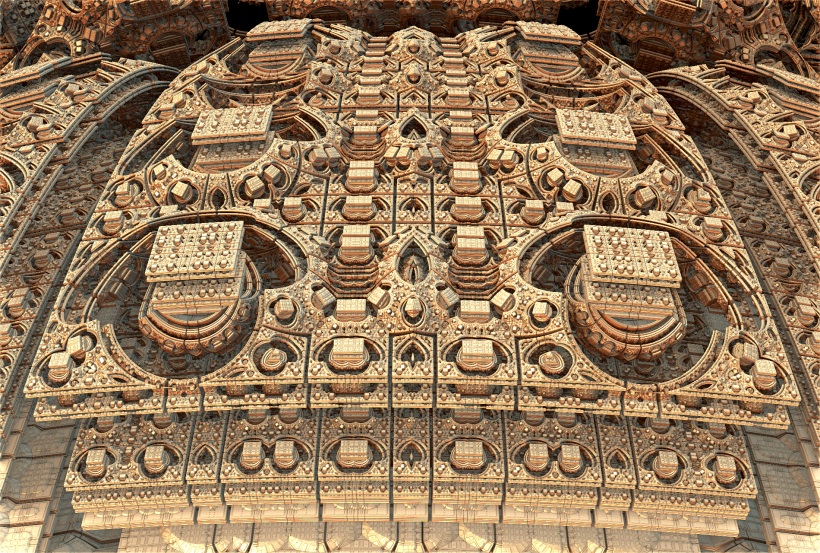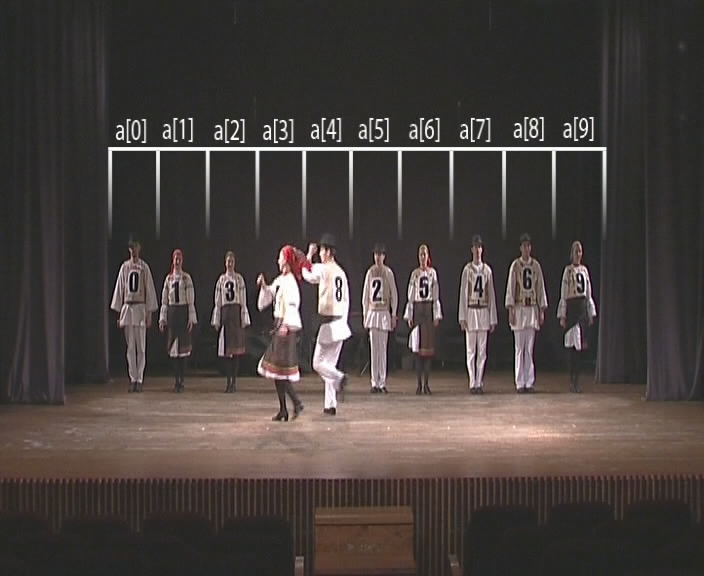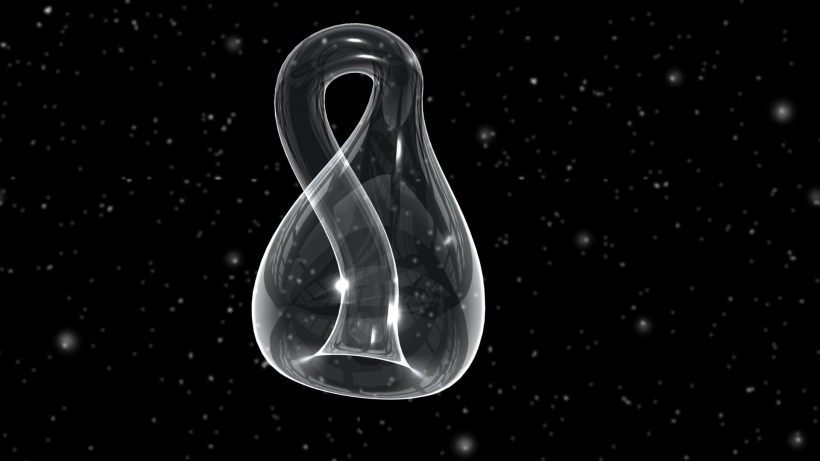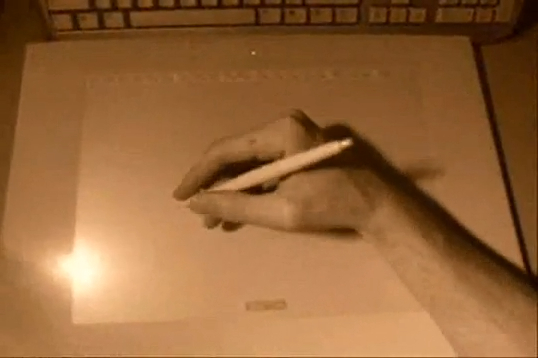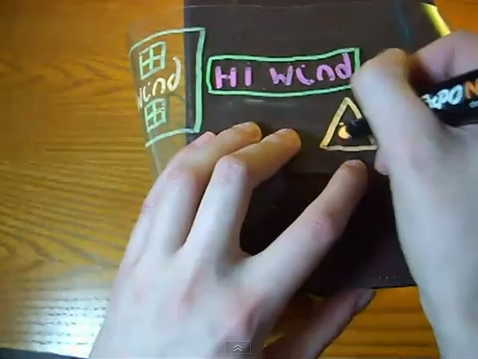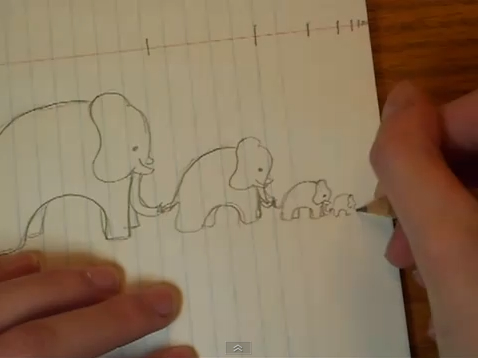2011 Short Movie Festival
More artists and educators than ever are using movies, videos, and animations for different purposes ranging from education, industry, and art. To further the Bridges Organization objectives, we continue our efforts to introduce participants to innovative and integrative techniques in the fields of mathematics and art. A new venue in this regard is The Bridges Short Movie Festival that we started last year.
Location
Bridges Lecture Hall
Saturday July 30, 2011
2:00 - 3:00 PM
Moderators: Nathan and Amy Selikoff
There will not be a printed program this year. You can read about the artists and their movies below, or download this page as a PDF. Most of the images below link to a YouTube version of the short movie.
Vladimir Bulatov
Independent artist
Corvallis, Oregon, USA
info@bulatov.org
bulatov.org
I've created my first dynamical kaleidoscope in the hyperbolic plane in 1997 when Virtual Reality Modeling Language was very popular tool to deliver interactive 3D graphics on the web. It was real time VRML animation, which was running on a standard PC with hardware accelerated graphic card. Since that VRML have died, no tools to replace VRML was created and I have learned, that hyperbolic kaleidoscopes can exist in 3 dimensions and can be bended and deformed in a variety of ways. Here I present prerecorded animations of are prerecorded animations I have made by animating parameters simplest bendable hyperbolic kaleidoscope with 4 mirrors.
Hyperbolic Kaleidoscope I
4 min 10 sec
Vladimir Bulatov: animation
Galina Bulatova: music selection
2011
Animation of hyperbolic kaleidoscope made by bending Fuchsian symmetry group. Music "Aria [Orchestral Suite No.3 in D minor]" by Johann Sebastian Bach. Background is made from images by Ernst Haeckel “Kunstformen der Natur 1899-1904” with transparency channel by Scott Draves.
Hyperbolic Kaleidoscope II
4 min 10 sec
Vladimir Bulatov: animation
Galina Bulatova: music selection
2011
Animation of hyperbolic kaleidoscope made by bending Fuchsian symmetry group. Music "Toccata & Fugue D Minor" by Johann Sebastian Bach. Background is made from images by Ernst Haeckel “Kunstformen der Natur 1899-1904” with transparency channel by Scott Draves.
Aurora
freelance artist
Woodstock NY
info@flyingrainbowlasagne.com
www.FlyingRainbowLasagne.com
This year, I started making animations of my artwork in order to explain the concepts displayed in my 2D paintings. When a person views one of my paintings, they may not conceive that they are actually looking at a static cross-section of a moving 3D scene. When I am painting flat circles, in my mind's eye, I am painting spheres.
Animations allow me to deconstruct a painting so that the viewer can more easily perceive the relationship of size with color, and recognize how consistently the proportions of the color recipe are applied.
The goal of these animations is to take the viewer on a step-by-step journey through the formation of these images and in doing so lay out the basic vocabulary for the universal language of color, shape, form, and movement. The culmination of the journey is the formation of The Flying Rainbow Lasagne shape which, in this universal language, is a visual 'how to' manual.
Beginning with the basic calibration of seven circles and their corresponding colors, the film moves on to show how these circles nest and overlap, and how this relates to my 2D paintings. Next, the animation gets more detailed, using spheres to show the movement of the energy, and how this relates to the chakras on the body and the human form. Finally, the movement of the spheres is shown in overlapping layers, adding up to The Flying Rainbow Lasagne shape.
The Conception of The Flying Rainbow Lasagne
4 min 28 sec
Aurora: animator/artist
Leland Gurrieri: original music
2011
There exists a visual language of color, shape, form, and movement. Like other languages, this one has letters (individual shapes) words (groupings of nested circles and vortexes) and grammar (the rules of formation and movement of the shapes.) Grammar is also expressed in color choice and color proportion. The rules of this language are arranged in such a way that for a 'sentence' to be 'grammatically correct' it must not contradict any of the previously established rules which form the foundation of the language. This means that some shapes and their movements are "allowed" and others are "against the rules."
The Flying Rainbow Lasagne is a shape that is "allowed", even though it may seem to be "against the rules." The Flying Rainbow Lasagne is comprised of seven spheres, each one corresponding to a color of the rainbow. Each sphere also conforms to the color proportion or 'recipe' for white light in which red is the largest unit and violet is the smallest unit and is always 1/7th the size of red. One of the rules of grammar is that there is only 1 violet, or that violet by it's definition is singular, and that having two violets would be like having two ones, which is actually having two. When viewing The Flying Rainbow Lasagne, it appears that there are two violets, one at either pole, which would be against the rules. However, there are not two violets. There is only one violet which is jumping back and forth so quickly it is as if it's in two places at the same time. Another way of saying this is that there is only one violet, and it is vibrating up and down in hyperspace, or, the violet is staying in one place as the universe jumps up and down around it.
This is significant because it is a refinement of or a new way of using the pre-existing rules without contradiction in order to do something that could not have been done before. Imagine an ant walking on a sheet of paper, who can never see or talk to the ant on the other side of the paper. By introducing a new dimension, or learning how to fold the paper, the two ants are now able to interact. In exactly the same way, introducing the idea that the violet particle is actually vibrating back and forth in another dimension adds an additional degree of freedom, in this case, allowing for greater interaction between the world of hard matter at the macroscopic level and the clouds of indeterminate probability at the quantum level. This could also be described as combining the worlds of the physical and the non-physical, where the physical world becomes more fluid and changeable and the non-physical world achieves some stability and solidity. To the human experiencer, this translates as a greater interaction between their physical body and their non-physical thoughts/feelings/internal perceptions, as well as the resultant manifestations of that interaction.
Rosanna Iembo and Irene Iaccarino
Mathematician, professor (Iembo) and violinist (Iaccarino)
Scafati, Italy (Iembo) and Crotone, Italy (Iaccarino)
rosannaiembo@libero.it
irene.iaccarino@hotmail.it
Rosanna and Irene are mother and daughter. We want to show that there has always been a strong link between math and music. How can we show this? By a film which joins together music, history, math, image in a story, in a poem.
"It was the year....."
6 min 14 sec
2011
The movie tells the history of the school of Pythagoras and of the city where he founded this school: Crotone in southern Italy.
But this is not a melancholy story of the past: it is a story of the future.
The future of the third millennium.
Matjuska Teja Krasek
Artist
Ljubljana, Slovenia
tejak@yahoo.com
tejakrasek.tripod.com
Krasek's theoretical as well as practical work is especially focused on symmetry as a linking concept between art and science, on filling a plane with geometrical shapes, especially those constituting Penrose tilings (rhombs, kites, and darts). The artworks among others illustrate certain properties as golden mean relations, selfsimilarity, fivefold symmetry, Fibonacci sequence, inward infinity and perceptual ambiguity.
Krasek's work concentrates on melding art, science, mathematics and technology. She employs contemporary computer technology as well as classical painting techniques. Her artworks and articles are exhibited and published internationally.
Krasek's artworks are among the winners of the 2nd, 3rd and 4th International NanoArt online competition. With her mathematical movies (video-animations) she wants to present the beauty of mathematics to young population in an unconventional and fun way.
Oxygene 6
6 min 46 sec
Jean Michel Jarre: Music
Teja Krasek: Video production
2010
Everything flows... everything is universally entangled. Life and love, lives and loves, our thoughts and eternal dreams all have their rhythms, structures, and orders. Births and deaths, new beginnings and endings, the eternal cosmic music, the harmony of the worlds -- interconnectedness in all.
The symmetries and dissymmetries of Jean Michel Jarres's beautiful musical composition 'Oxygene VI' reflect in this visual analog where organic forms of strange attractors meet geometrical forms.
Brecker 8
1 min 2 sec
Harlan Brothers: Music
Teja Krasek: Video production
2010
The movie is a joint work with Harlan Brothers, a composer, mathematician, inventor, and educator who had the honor and pleasure of working with the late Benoit Mandelbrot, who first suggested to him to investigate what it means to say that a piece of music is fractal. After generating the piano solo heard in this composition, it struck Harlan as reminiscent of the saxophone work of Michael Brecker. "Brecker 8" resulted from Harlan's ongoing investigation of: 1) the relationship between fractal dimension and melodic structure, and 2) one's ability to directly perceive different dimensions. The piano solo in this piece has a statistically self-similar distribution of melodic intervals with dimension 8, and I tried to visualize the beautiful composition with playfulness of geometrical shapes.
Curtis Palmer
President, Synergetic Design Inc.
Edmonton, Alberta, Canada
clpalmer@shaw.ca
gallery.me.com/clpalmer1#100046
I am a bit wrangler-hungry for simplicity and for technique. What could be simpler? Great circle mirrors, 27 intersecting screens, 27 self-referential texture maps, an orbiting camera, and a ray-tracing renderer for 144 hours? The aim of this movie is a visual mnemonic depicting radically different consequences, different points of view arising from an underlying unity: common center angles.
27 Blue Kaleidoscopes
5:41 min
Curtis Palmer B.Sc., M.Des.: Animator and Guitarist
2011
27 Blue Kaleidoscopes opens with a 1 minute behind the scenes explanation of how the movie was made. The camera then loops through a maze of intersecting great circle mirrors. The spaces between the mirrors are populated by 27 screens made from 42 surfaces, each textured by a signature luminous blue cyclon and 50 edges that are spanned by a small diameter red pipe. And yet we see 27 polyhedra with over 400 surfaces and 800 edges in this orbital sweep of slightly less than half a sphere.
The music was composed and recorded while the movie was rendering and records the artists discovery of the F Major scale.
Mehrdad Garousi
Freelance fractal artist, painter and photographer
Hamadan, Iran
mehrdad_fractal@yahoo.com
mehrdadart.deviantart.com
For decades it was only possible to generate two dimensional fractals until an outstanding breakthrough in recent years provided us with new prospect of having fractal dimensions in our computers in the more tangible third dimension. In this way we can pass inside fractional spaces among 3D mathematical shapes like our usual experience in our real life. At present, these journeys are not easy enough and require spending hours and sometimes days to be designed and usually weeks to be rendered digitally.
But this is only a beginning. At present, it is only possible for artists to have live journeys through fractals, due to speed limitations of computers. In the near future, having super-fast computers we hope it will be possible for everyone to experience a live journey inside fractals and step through the farther unknown areas for themselves. Such real time interactive fractals could be used in other fields like video games as well to invite chaosity and some kind of randomness or bizarreness to landscapes. Exploiting new equipments of 3D eyeglasses, screens, and holograms will also cause new breakthroughs in this promising route.
Quest
3:09 min
Mandelbulb3D software (a free software)
2011
This animation is a three dimensional journey inside a 3D fractal formula known as “Amazing Box”. The journey starts from the dark empty space outside the fractal shape and intrudes the endless constructive details of such an amazing shape with fractional dimension. The farther we go ahead, the more details we appear to quest. I started this journey without any forehand provided plan and selected the paths according to my instant sense inside those amounts of complexity and chaos around me. Such 3D representations of fractals, entirely constructed on the basis of fractal mathematics of nature, could inspire future constructions of human kind in the future world, for real or virtually.
The music of the animation, exploiting 13 instruments sound samples, is composed according to a number of sequences and maps related to number theory, chaos and Cellular automaton including Morse-Thue Sequence, Gingerbread man, Henon, Wolfram one-dimensional Cellular Automata, and Lorenz algorithm.
The animation is made in Mandelbulb 3D and the music in FractMus 2000.
Special thanks to my friend Vahid Barzegaran whose hexa-core CPU rendered the animation, sized 1024 x 768 pixels, in 27 hours while it might have taken my dual-core CPU over 130 hours.
This animation is going to be displayed as well at the First International Conference "Art, Science and Technology: Interaction between Three Cultures" at ORT Braude College, Karmiel, Israel.
Zoltán Kátai and Albert Füzesi
Assistant professor Sapientia University (Kátai) and Choreographer, “Maros művészeggyüttes” (Füzesi)
Tirgu Mures, Romania
katai_zoltan@ms.sapientia.ro
The movie presents a “Csángó” (Transylvania, Romania) folk dance that illustrates the bubble-sort algorithm. The main goal of our project was to promote both computer science education (teaching-learning sorting algorithms) and appreciation for cultural diversity in Transylvania, Romania. We created six choreographies (Romanian, Hungarian, Transylvanian Saxon, “Székely” and “Csángó” folk dances that illustrate six different sorting algorithms) that equally promote multiculturalism and computer science (and mathematic) education. (“Csángó” is an ethnic group that lives in Transylvania, Romania).
Bubble-sort with “Csángó” folk dance
5 min 16 sec
Kátai Zoltán: Director
Tóth László: assistant
In cooperation with "Maros Művészegyüttes", Tirgu Mures (Marosvásárhely),
Füzesi Albert: Choreographer
Lőrinc Lajos, Körmöcki Zoltán: Video
Supported by "Szülőföld Alap", MITIS (NGO) and Evoline company
2011
The movie illustrates an optimized version of the bubble-sort algorithm. The number-sequence is personified by the dancer-sequence (dancers wore the corresponding number on their dress). Proper dance-steps were chosen (according to the defining characteristics of the “Csángó” dance) for all key-operation of the algorithms. The choreography has a dynamic intro simulating the mixing process of the numbers and ends with a vivid finale emphasizing the ordered character of the sequence. The central part of the choreography closely follows the sorting strategies. Graphical elements (applied to the video-recordings) emphasize that number-sequence is stored in an array.
Konstantin Weixelbaum and Ilkay Sakalli
Dipl.-Math. at Free University Berlin 2011 - recent graduate
konstantinweixelbaum@gmail.com
www.klein-bottle-film.com
The Klein Bottle started fascinating me during my studies of Geometries and my goal with this animation was to show aspects of it that haven’t been captured in a film before.
The movie has an educational purpose: It teaches complex topics from differential geometry and topology in a very visual way and therefore make it also accessible and appealing to a general public that is drawn by the beauty of the Klein Bottle.
I believe that Mathematicians need to focus more on explaining to the public what applications their mathematical techniques are used for and if possible, visualize the results to draw more attention. More people will get interested to study the core of the problems and also try to face complicated formulas and concepts, that on the first sight seem too difficult. Short Movies, many pictures and interactive websites should be part of almost every Mathematics Textbook, High School Class or University Lecture, in my opinion.
The Adventures of the Klein Bottle was produced using Javaview and Autodesk Maya: animations show how a flat paper can be transformed into the Klein Bottle, how two Moebius strips form a Klein Bottle and how a Figure 8 curve rotating with a half twist forms the Figure 8 Klein Bottle.
Deformations were performed using a custom made MEL script, converting models from Javaview animations into Maya keyframe animations.
The Adventures of the Klein Bottle
3 min 56 sec
A short film by Konstantin Weixelbaum and Ilkay Sakalli
AG Animate, Prof. Dr. Konrad Polthier
Department of Mathematics and Computer Science Free University Berlin
Music: GEMAfreie-welten
2010
This animated short film gives never seen before views into the Klein Bottle, which was a breakthrough in surface topology.
The Klein Bottle is a classic surface that fascinates mathematicians since it was first described as a “double surface” by the German geometer Felix Klein in 1882. Nowadays it is described as being non-orientable, that means it is one-sided, there is no inside or outside – this property links it closely to the Moebius strip.
The film shows an animation of the original notes of Felix Klein and a wild race over the surface of the Klein Bottle.
Ian Padgham
position
location
ian@origiful.com
origiful.com/
I have always been fascinated by mathematics, linguistics, and art. I am especially fond of iterative manipulations and playful repetition and have done several works based on the art of M.C. Escher. I even have a permanent installation in central Paris that combines numerous mathematical processes ranging from anamorphic Renaissance tricks to Escher-esque tessellations. I am continually inspired by the aesthetic possibilities of systems, patterns, and codes.
MC ESCHER - amazing hands
2 min 56 sec
2007
M.C. Escher's famous image of two hands drawing each other is brought to life using animation techniques and computer illustration.
Vi Hart
Recreational Mathemusician
New York, NY
vi@vihart.com
vihart.com
Möbius Story: Wind and Mr. Ug
7 min 15 sec
2011
A cautionary tale.
Doodling in Math Class: Infinity Elephants
4 min 36 sec
2010
